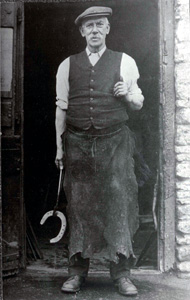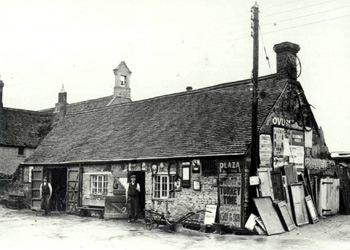The Old Smithy 49 High Street Harrold

The Old Smithy in the late 19th century [ref: Z50/54/23]
The Smithy and its Blacksmiths
The Crouch family were blacksmiths in Harrold for at least three generations. James Crouch, who married Elizabeth Arpin or Orpin on 7th May 1811, was noted in the first directory to mention Harrold (1830), as blacksmith. He was the son of William and Sarah Crouch (née Fier) who had married on 19th February 1787, James being baptised on 4th July 1791. His father William was the son of John Crouch and Sarah Abraham and was baptised on 1st April 1759. A John Crouch, son of Christopher and Ann was baptised in 1747 (if this was the same John then he must have been baptised when he was already some years old). Parish registers sometimes give occupations, but not those for Harrold at these dates and so we do not known whether William Crouch and his father John were also village blacksmiths [see below for a claim that the family had been blacksmiths since 1740]. No house on the 1671 Hearth Tax return is noted as containing a forge.
James Crouch was buried on 4th February 1838, aged 57, showing either that the vicar was mistaken about his age or that he was illegitimate and baptised at ten years of age. James and Elizabeth's son was Christopher and he duly followed his father's career as the smith. He had been born in 1811, the year of his parents' marriage and was buried on 28th April 1885, aged 75. Christopher and Martha Crouch had a son, Thomas, who followed the family trade. He was born in 1833 and was buried on 23rd January 1899.
A photocopied letter from W. Trethewy of Silsoe, who owned the land at the time, to Frederick George Crouch, dated 5th April 1894 states: "Your uncle having given notice to quit the Blacksmith's Shop at Harrold I will accept you as tenant upon the same terms and conditions as he held it, and I hope you and he will have no difficulty in arranging for what fixtures, if any, there may be on the premises belonging to him".
In 1927 property in Harrold was valued under the Rating & Valuation Act of 1925; every piece of land and building in the country had to be valued to determine the rates to be paid upon it. The valuer visiting the smithy [DV1/C71/131] noted that it was both owned and occupied by Frederick George Crouch. It was a stone and tile building standing in 0.155 acres and comprised a shoeing shed measuring 14 feet by 15 feet and a smith's shop 32½ feet by 15 feet; outside, to the rear, were a large wood and felt shed and a small lean-to in a large yard. The valuer remarked: "Very useful and used".

Frederick George Crouch [ref: Z278/4]
Frederick George Crouch
Frederick George Crouch lived at 50 High Street. A newspaper cutting from 1934 [ref: CRT130Harrold18] has a photograph of him as well as a short article: "Mr F.G.Crouch has been a blacksmith for over 62 years, all spent, with the exception of three years, in the same working premises. In all that time, and including two years work in the leather trade before he became a smith, he has never once had a full week's holiday. Shoeing must be a healthy occupation, for Mr Crouch has never spent a week in bed because of illness during that period…".
He died in 1941 and was buried on 3rd March that year. The contents of the smithy were put up for sale by auction on 28th March 1941 and realised £163/12/- [ref: PK2/3/1/27]. His obituary in the Bedfordshire Times read: "One of North Bedfordshire's best known and best respected people, Mr Frederick George Crouch , the blacksmith of Harrold, died early on Tuesday morning in his seventy-eighth year. A multitude of people will mourn his death, for his was a life lived in accord with Christian principles, and his association with Harrold had been so long that he was literally "part of the village". He was greatly esteemed for his shrewdness and much liked for his never failing kindness and tolerance.
"Mr Crouch's end came with comparative suddenness. Until a fortnight last Saturday he had never been confined to his bed with illness, and up to that day he was still working in his smithy, although it was apparent to his friends that his powers were failing. Then he became ill and had to take to his bed, and for the last few days he was unconscious.
"He held two notable records. For sixty five years he was a blacksmith, and for something like forty five years he acted as Bedfordshire Times correspondent for Harrold, a service which he rendered to everyone's satisfaction.
"Mr Crouch was one of the few remaining village craftsman and was a typical representative of that rural culture which has largely been destroyed by the encroachment of mechanization. He was born on 12th April 1863. His father, Mr George Crouch, was the youngest son of Mr Christopher Crouch the village blacksmith and Mr F.G.Crouch was the last of a line that could be traced back to 1740. The ancestor of 1740 was also named Christopher and Mr F.G.Crouch's father, like three of his brothers, was also a blacksmith, and they all learnt the trade at home.

Blacksmith Frederick George Crouch and his forge [ref: Z50/54/22]
Schooling in Mr Crouch's childhood was in some contrast to the conditions and methods obtaining today, even in the most remote village school. Mr Crouch used to recall that he and his schoolmates first had to visit the stationer's shop to buy slates and pencils before going to school, The labouring classes paid a penny a week for each child's schooling but as a tradesman's son Mr Crouch paid twopence. In the school holidays he went with other boys to work on the farms. His wage for picking twitch for a week was 1s. 6d. When Mr Crouch was about fourteen years of age he began work as a blacksmith for his grandfather in the present shop. A few years ago Mr Crouch's reminiscences were published in The Bedfordshire Times and he said on that occasion: "Compared with present day conditions the work then was slavery. There were four of us altogether and we worked from six o'clock in the morning until seven or eight o'clock at night. We never worked less than sixty five hours a week. My grandfather always had apprentices and these were paid but very little. I had the same. The journeyman who lived in received from nine to ten shillings a week. Board and lodgings were provided and there was always plenty of beer, which was brewed on the premises.
"All the horse-shoes in those days were made from old horse-shoes and any other heavy old iron that was available. There were two forges and generally two strikers, but in the winter evenings the farm lads would in and lend a hand, for they had nowhere else to go, save the public house".
"Not until he was twenty one years of age did Mr Crouch receive any wages, his parents having to provide for nine children. When he came of age he went to work at Sandy , because he had begun to get "restless and dissatisfied".
Parish records reveal two 18th century blacksmiths in Harrold - Gideon Perry in 1708 [ref: P33/14/2] and Henry Dodson in 1715 [ref: P33/14/5].

The Old Smithy, 49 High Street, in May 2008